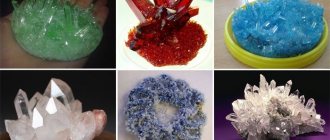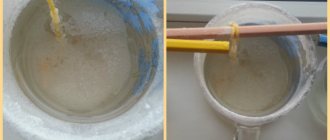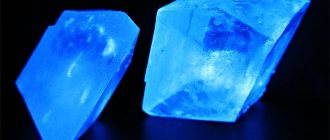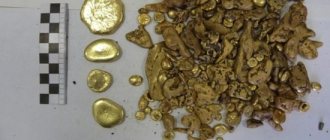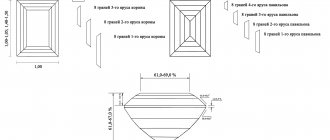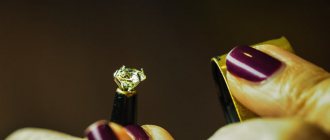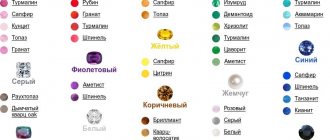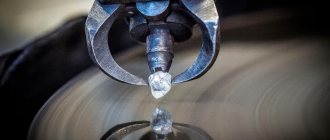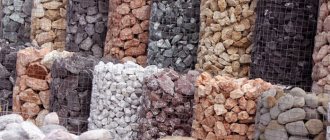Growing real ruby crystals at home
Hello, dear friends, I am glad to welcome you again. Let's continue to talk about precious stones today, because their beauty and play of facets are worthy only of admiration and praise. Few people have heard that growing ruby crystals at home is not a myth, but a reality that you can touch if you wish. An interesting way to obtain synthetic analogues of ruby allows you not only to find a favorite hobby, but even to develop your own business. Let's understand together all the processes and nuances of this work, discovering something new for ourselves.
Popularity of artificial crystals
Only a professional can evaluate the authenticity of a gemstone, using his experience, knowledge, and special equipment. For most people, the subtle differences between the original and the artificial analogue are almost invisible. In many cases, synthetic stones even surpass real rubies in their beauty and purity of color. During the growing process, a perfect crystal is formed, and the master only emphasizes its perfection with cutting. There are no defects or foreign inclusions, as can often be seen even with high-quality rubies.
Large commercial enterprises often use counterfeit rubies in the jewelry manufacturing process. Only a jeweler knows how to recognize a replacement; for others, jewelry is simply a model of perfection. The popularity of such a product lies in its affordable price, because not everyone can afford a ring or earrings, a necklace decorated with a precious ruby.
Features of creation
Synthetic gems are a complete analogue of natural gems. The difference lies only in the nuances of creation - artificial jewelry is created in laboratories or special factories, where a large number of specialists help the stone to be “born”, observing all the subtleties of the technological process. In terms of chemical and physical characteristics, artificial stone fully corresponds to its natural counterpart, therefore it cannot be considered a glass imitation or fake. This is a high-quality, full-fledged analogue.
Precious gems that are created under artificial conditions have another name - grown jewelry stone. It fully reflects their essence. The technologies for creating artificial jewelry are completely identical to the conditions that nature creates for them.
But technology significantly reduces the time it takes to create stones. If a natural gem can be created over hundreds of years, then an artificial analogue will require several hours, in rare cases - several months. Initially, equipment and technology for creating artificial stones were very expensive. Therefore, the stones could not be too cheap. But this process is constantly being improved, due to which the cost of such jewelry is reduced.
Scientists have spent a lot of time, effort and money developing synthetic stones. And their discoveries are of great importance, which lies in the following factors:
- reduction in the cost of jewelry, which has become more affordable with artificial gems;
- creating the perfect stone without unnecessary inclusions and other shortcomings, because nature does not always manage to create the perfect gem;
- replacement of precious stones, the reserves of which are not unlimited in the bowels of the earth;
- expanding opportunities for the use of precious stones in industrial applications.
Noble motives motivated the scientists. Unfortunately, their creations have opened up opportunities for fraud, as many try to pass off artificial stone as natural and make good money at the same time.
How to grow artificial ruby
Growing synthetic rocks can turn from a fun hobby into a real home business idea. There is a well-known way to make a ruby using various salts or even sugar. The process will take quite a long time, and the quality of the resulting crystal ultimately does not satisfy many.
To set up home ruby production, you should purchase a special Verneuil apparatus. This scientist was the first to make a stone that resembles a real gem in composition and quality. Literally before our eyes, a ruby up to 30 carats in size grows, which amazes with its beauty and attractiveness.
The technology is quite simple and can be done by anyone who wants to do this business.
- An aluminum dioxide salt containing an admixture of chromium oxide is placed in the system's storage tank.
- An oxygen-hydrogen burner melts the mixture.
- The crystal “grows” literally before our eyes.
The color of the resulting stone can be adjusted independently by selecting different salts. This type of work requires care and consistency. The resulting crystals lend themselves perfectly to further processing and polishing. They turn out very beautiful and transparent. They are happily bought by jewelers to create various jewelry, craftsmen who make interesting compositions and crafts.
The resulting synthetic rubies are, of course, not jewelry. Professionals have simple ways to check the authenticity of the material, but even with a visual inspection they see the characteristics inherent in the synthetic analogue.
If you decide to grow crystals and sell them in the future, such activities should be licensed, guided by legal norms.
How to grow rubies from sugar
From small sugar crystals you can also grow worthy analogues of an expensive ruby. The solution must be made using the same technology as with salt. Next, lower the cotton wool into the composition and wait until crystals begin to form on it.
Please note that the active growth of a future ruby may slow down significantly. This indicates that the sugar concentration in the solution has begun to decrease. To restore the growth process, add a little more sugar to the water.
You can experiment with the shades of the stones you grow. To do this, add food coloring to the solutions.
To make the crystal look even more impressive, use a wooden stick instead of a thread or cotton cord.
- Prepare syrup of the required consistency and temperature of 50 degrees.
- Dip a wooden stick in it and roll it well in sugar. Try to leave as many sweet grains as possible on the surface, the final result depends on this.
- Pour the finished syrup into a clean container (it’s better to take a glass glass).
- Add food coloring of the desired shade in the required quantity.
- Place a stick in the glass, make sure that it does not touch the walls of the container, otherwise the crystal will turn out ugly. For additional fixation, use a sheet of paper, placing it on top of the stick.
- Leave the preparation for about 7 days. Make sure that the crystal growth does not slow down. In a week, you will have bright crystals that can even be used as a dessert, because there are no foreign additives in them.
Such an experiment, of course, is unlikely to become an idea for business, but children can be involved in the work process. They'll love growing colorful ruby lollipops for themselves and their friends. You can make various crafts from ready-made crystals without limiting your creative imagination.
How to grow bright crystals from salt yourself
This experiment is the simplest and most accessible for anyone who is familiar with the topic of growing crystals.
To work you need to prepare:
- rock salt;
- water - it is better to take distilled water, it contains a small amount of its own salts, and it has maximum purity, which is very important;
- a container of a suitable size - it could be: a pan, a glass, a jar.
Step-by-step instructions for growing crystals.
- Pour water into the container, preheating it to 50 degrees.
- Add kitchen salt, stir well until completely dissolved.
- Add a little more salt and stir again.
- Add salt until it stops dissolving and precipitates at the bottom of the container. This will indicate that the solution has the desired consistency. Make sure that the water in the container does not cool down, but is at the same temperature, this also contributes to the saturation of the composition.
- Pour the finished solution into a clean container, separating it from the sediment.
- Select a single salt crystal and place it in a container. For convenience, you can tie it with a thread, fixing it in a hanging position.
- Now all that remains is to watch how the crystal becomes larger day by day, acquiring new elements.
Jewelers have many ways to test the quality of a ruby, but if you are simply looking to bring something beautiful, bright and attractive into your life, start growing stones yourself.
How to make money on artificially grown stones
Precious stones have always attracted man. But in our time, and earlier, most of these creations of nature are considered a rather expensive purchase.
The solution was found by scientists who managed to synthesize a gemstone that was not much different from its natural counterpart. The idea quickly gained popularity.
Currently, artificially grown stones are often used in jewelry.
The thing is that jewelers determine the value of a stone based on a number of criteria:
- stone color,
- light refraction,
- strength,
- weight,
- size,
- number of edges.
Enterprising people have found a way to grow such stones at home. Some make a business out of this, taking advantage of the popularity of synthetic crystals.
Their sale will not be a deception, because from the point of view of physics and chemistry, the properties of artificial stone are almost completely identical to the real thing.
Anyone can start growing crystals; it is not necessary to have any specific knowledge. You just need to strictly follow the instructions.
If done correctly, you can earn decent money from this.
Autoclave
Other gemstones, such as emerald, require a growing method that involves placing the raw material in water. To do this, you need to purchase a special autoclave device, as well as beryl, vanadium and chromium. The advantage of the device is that it can withstand high pressures and temperatures. The production process is as follows:
- Heating of the device.
- Place crushed beryl, water and additional elements in the hot compartment of the autoclave.
- When it reaches 600°C, the melted beryl moves to a cold compartment, where it settles to the bottom, forming an emerald.
Approximate production time is four weeks. And although the device and materials are quite expensive, the final profit will be very high.
Using an autoclave you can grow not only emeralds, but also other jewelry.
When experimenting, do not forget that you are working with chemicals that can be dangerous. Do not use medications without instructions or assistance from specialists. And of course, when working with chemical elements it is necessary to wear protection. The result is worth it - homemade crystals are not inferior in beauty to purchased ones.
The most controversial stone
Everyone knows that the most expensive gemstone is the diamond. It is cut and sold as a diamond. But in fact there is a more interesting option.
The stone in question is called alexandrite.
It is a type of the mineral chrysoberyl or beryllium aluminum oxide.
In nature, it is quite rare and usually weighs no more than 1 carat.
Artificial stones sell for $300 per carat.
This high cost is due to the complexity of production. It is grown by melt-pulling.
The operation is quite difficult to perform, is performed at high temperatures and is not available at home.
But despite this, there are a huge number of artificial stones on the market, which are often difficult to distinguish from real ones.
How can you make money?
It is most profitable to grow ruby crystals.
The red stone does not lose popularity and, if properly implemented, will bring good income to the manufacturer.
Rubies are not only used in jewelry, but also used in industry.
For production on a decent scale, special equipment is needed, which was named after its inventor the Verneuil apparatus.
It allows you to grow crystals right before your eyes.
In 3 hours, the weight of the stone can reach 20 carats.
With minimal costs for electricity and reagents, this brings enormous profits.
Of course, as in any business, it is necessary to make efforts and monitor the equipment, but in the future it is possible to grow not only rubies, but also emeralds, topazes and even some kind of diamonds.
The resulting stones are easily processed and used for their intended purpose.
Only a professional can distinguish such stones from real ones. From the point of view of the average person, they will be like two drops of water similar to their natural counterparts.
From the point of view of the law, they will not be precious stones. No additional licenses are needed.
However, if implementation is carried out, it is worth taking care of opening a legal entity.
Imitation inserts: a little history
The most popular imitations of precious and semi-precious stones in jewelry are cubic zirconia and Swarovski crystals (rhinestones). Remember, cubic zirconia is not an artificial diamond! It does not contain carbon, the main element for diamonds, but contains zirconium oxide. Cubic zirconia was obtained in the mid-1960s by scientists at the P. I. Lebedev Physical Institute of the USSR Academy of Sciences (FIAN), after whom it was named.
The idea of imitating diamonds using cut lead glass was invented in the 18th century by glassmaker and jeweler with German roots, Georg Strass, who lived in French Alsace. The master’s surname became the name of his invention: the spectacular inserts were called “rhinestones.” A century later, Strass's ideas were developed by Daniel Swarovski, a hereditary cutter of Bohemian crystal. He improved the composition of rhinestones, the quality of polishing and the durability of spraying, so that they were not inferior to diamonds in the beauty of cut, transparency, play of light and brilliance. In 1895, Daniel founded the Swarovski company in Austria to sell his products to the whole world and primarily to fashion designers in Paris. The business of the talented cutter, inventor of the first electric cutting machine (1892), thanks to the efforts of his descendants, continues to flourish today. Swarovski crystals (rhinestones) have 12 facets, are made from high-quality crystal (glass with 32% lead oxide content) with the addition of powdered synthetic and natural stones of jewelry value.
Non-standard earnings on “blooming” stones
An interesting feature: when people hear about artificially grown stones, they tend to think of them as precious.
However, there are so-called “living stones”.
This is the name given to flowers of interesting shapes that amaze with their beauty.
Such a plant is Lithops.
Its natural habitat is the deserts of South Africa.
This flower is a succulent and has very thick leaves that strongly resemble processed granite. Once a year, in the spring, the birth of new leaves occurs, associated with the death of old ones.
You can't call him tall. As a rule, the maximum height of the plant is 10 cm. It blooms from September to November.
Planting a plant
Such flowers will be very interesting on sale. The plant is quite unpretentious, so you can grow it at home.
Since propagation occurs through seeds, the main difficulty is planting.
The seeds need to be placed in water for several hours, and then planted close to the surface of the earth. The planting needs to be covered with film to create a mini-greenhouse.
Every day you need to spray with water and ventilate for 3 minutes.
It is advisable to maintain the temperature below 30 degrees during the day and above 15 at night. It is also worth taking care of good lighting and humidity.
Conditions of detention
Lithops do best in medium-sized pots.
Despite its small size, the plant has a very extensive root system, suited to the desert. It should fit well in the pot.
It is also advisable to plant 2-3 flowers in one container so that they take root better.
Pots should be placed in warm, well-lit areas. If possible, let them be on the south side of the house.
You should not change the location often - the plant is sensitive to movement.
It's better not to touch it at all.
Rocky soil is optimal for lithops. It suits him best. You can add coarse sand, small pieces of stones and humus.
There is no need to suddenly change environmental conditions. The plant loves a temperate climate and does not tolerate sudden temperature fluctuations.
Also, do not overfill the pot. You don't need to water too often. You need to make sure that water does not get between the leaves.
Watering is strictly prohibited during the dormant period, when all processes in the plant freeze.
Home experimentation
It is recommended to start growing rubies with small volumes. First, experience is gained, the whole process is understood, and then direct systematic work begins. Synthetic creation of your own hands will not be inferior in beauty and attractiveness to natural minerals. The stones are in demand among jewelers, so a successful experience can bring additional income if a market is found.
There are several ways to grow. They advise you to try all the options, then settle on the one you like.
Artificial precious rocks created by man do not differ from natural ones in their chemical content and physical properties. The advantage of home technology is that it allows you to create perfectly pure breeds. In nature, this happens extremely rarely. The jewelry quality of laboratory samples is quite good. Another advantage of the mineral is its cost. The stones are cheaper than their originals, which originate in deep mines.
Varieties
Since the production of the first artificial gemstone, scientists have been able to significantly expand the list of gems that can be created in laboratory conditions. Synthetic gems are presented in a large assortment, among which the following options are the most significant and interesting.
Diamonds are actively produced artificially; moreover, this stone was one of the first to be synthesized. Now it will not be difficult for scientists to create a 15-carat diamond. Many jewelers use these stones in their jewelry, passing them off as real. It is becoming increasingly difficult to distinguish a real nugget from an artificial one, because scientists are constantly improving their skills. A real stone has mineral inclusions, while artificial diamonds have metal inclusions.
Artificial nuggets are not low in cost because the process of creating them is expensive.
Organic salts
It is easy to grow a ruby crystal from various salts:
- copper sulfate;
- potassium alum;
- regular salt.
The longest salt-based process, the most beautiful specimens are obtained from vitriol. The production of ruby crystals is based on the following stages:
- Preparing the container. It should hold salt and a saturated water-salt solution. They take hot water. The process is gradual. Dilute two tablespoons with water and mix thoroughly. Then salt is added and mixed. You need to sprinkle until the salt stops dissolving. To maintain the proportions, take a hint: a table of the solubility of different salts in 100 ml of water, their relationship with the temperature of the liquid.
- Filtration of the solution. The solution must be clean. Dirt impurities will ruin the structure of the stone. Defects will be visible in it. The solution remains for 24 hours. During this period, crystals form at the bottom of the container. They will become the basis of the ruby.
- Growth of an artificial mineral. A fishing line is tied to the stone formed at the bottom of the glass. It is wound around a pencil or wooden stick. The device is installed on the container. The crystal is in solution, in a suspended state. Water tends to evaporate, the saturated saline solution releases excess, which is fixed on the resulting sample.
- Adding salt solution. You always need a certain amount of water; if it becomes too little, the crystal will stop growing. At normal room temperature, water is added once every 2 weeks.
To obtain rubies at home, you will have to wait about 3 months. Then the stone is freed from the saline solution and dried with a soft cloth. The sample is coated with colorless nail polish in several layers.
Advice from experienced crystal creators. The salt solution should be at the same temperature as the water in the container. The crystal grows at a temperature slightly lower, but high rises in solutions spoil and stop the growth.
Device for working at home
To create rubies at home, you will need a machine named after its creator, Verneuil. The inventor's technique allows him to grow a ruby weighing 30 carats in 3 hours. Technology has made it possible to create precious material in the required quantities. Industrial capacities began to actively implement Verneuil's development. Time has made its own adjustments, and today such a device is easily assembled at home. Components of the device:
- cathetometer;
- shaking mechanism;
- bunker;
- burner;
- muffle;
- growing crystal;
- crystal holder;
- crystal lowering mechanism.
The device is used for growing not only rubies. The device often creates blue topaz, emeralds and stones with a translucent transparent structure.
Home production process:
- Powder is poured into the hopper through a funnel. The composition of the powder is Al2O3, the additional component is Cr2O3.
- Using a burner, a flame is supplied to the bottom of the hopper.
- The powder begins to melt.
- The layers of molten powder are a growing ruby crystal.
Through the lowering mechanism, the artificial mineral moves down. The device can produce different shades. The rate of crystal formation is higher than in a container. It will only take 3 hours, and you can admire the ruby. For one sample the following volumes of components are needed:
The raw crystalline formations are extraordinary in form. They are originally similar to natural ones, but at the same time always unique.
Working with the device at first glance is complex and painstaking. In fact, the device, invented by a French inventor more than 100 years ago, will not create any special problems. It is assembled from parts that practical people have on their farms. Making a device and purchasing powder are the main stages of preparation.
The essence of the method
Synthetic crystals are grown in autoclaves. These are thick-walled steel vessels with a sealed lid. Autoclaves are able to withstand pressures of more than 1000 atmospheres and temperatures of over 600 degrees for a long time.
The starting material - low-quality natural crystals - is placed in the lower part of the autoclave. They are filled with an aqueous solution with the addition of precursor salts.
To prevent the solution from causing corrosion of the walls of the autoclave, protective inserts are used. They occupy its entire internal cavity, or only part. The inserts are made of chemically inert and refractory metals - gold, platinum, iridium. This increases the cost of equipment, and, as a result, the cost of grown crystals.
In the upper part of the autoclave there is a seed made of natural mineral - a thin plate of beryl, corundum or quartz. Hydrothermal synthesis is carried out due to temperature differences. The autoclave is heated, causing the lighter solution to rise up, and the dense and cold solution to fall down. The cycle is repeated many times.
| Scheme of an autoclave for hydrothermal synthesis 1 - solution 2 - crystal 3 - furnace 4 - substance for crystallization (T1 |
